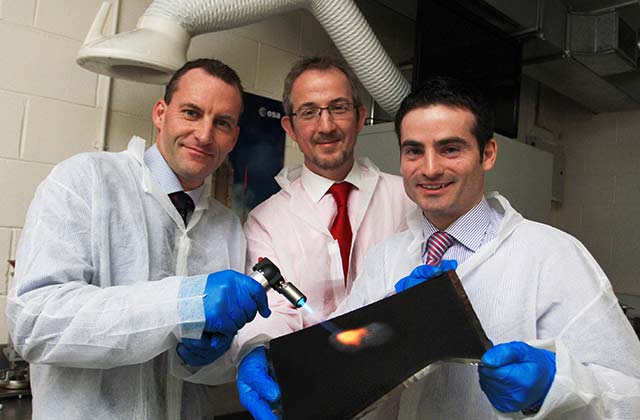Innovation and Commercialisation
Using DNA to pick a winner – what makes one horse faster than another?
The reason, they say, the Irish breed great race horses, is the limestone bedrock that stretches from the Curragh across the midlands to the Golden Vale in Munster. But, while that may very well be the case historically, the future of horse racing performance is more likely to be in the hands of UCD genetic scientist, Dr Emmeline Hill, whose spin-out company, (opens in a new window)Equinome, uses genomics technologies to examine panels of DNA variants that have been identified as being critical to racing performance.
Through this research, Hill has identified the 'speed gene' and more recently has traced its origins.
Equinome was co-founded in 2009 by Dr Hill in partnership with Jim Bolger, the renowned Irish trainer and breeder. It has succeeded in securing major clients in the bloodstock industry for the Equinome Speed Gene Test, the Equinome Elite Performance Test and the Equinome Projected Height Test, and now has clients in over 15 countries across the world, among them two of the top five global Thoroughbred operations.
This global reach is supported through the company's headquarters at NovaUCD and its Australian office. Equinome is also is planning to open an office in the USA.
In recognition of the global success and impact which Equinome has achieved in the international, multi-billion euro Thoroughbred horse racing and breeding industry Dr Hill was presented with the 2014 NovaUCD Innovation Award.
Presenting the award, UCD President, Professor Andrew Deeks said, "Equinome, established to commercialise world-class UCD research outputs, is an excellent example of a UCD spin-out company with global reach and sales. Equinome has already significantly changed breeding techniques in the global Thoroughbred industry, which had until then remained unchanged for hundreds of years."
To date thousands of samples from past and future Champions have passed through Equinome's laboratories at UCD on their way to the winning post and Equinome is on form to expand the use of genetic testing in the global Thoroughbred industry in the years ahead.
News links:
(opens in a new window)RTE News
(opens in a new window)Nature Communications
(opens in a new window)Racing & Sports Australia
(opens in a new window)Equine Chronicle
Social media profile:
Twitter: (opens in a new window)@Equinome
Infinite space for innovation
One of the side effects of innovation is that you don't always know where it's going to take you. Biomedical Engineer John O'Donoghue had been developing a functional coating material for hip implants from his base in a small industrial estate in the south of Ireland, but the medical devices sector can be very difficult to break in to. So, his decision as CEO of EnBio to spin-in to NovaUCD, the Innovation and Technology Transfer Centre at UCD, gave him more than just space.
"Having access to the university facilities and expertise has proven pivotal, allowing (opens in a new window)EnBio to rapidly build a tentative relationship with the (opens in a new window)European Space Agency (ESA) into a major opportunity".
Our interaction with Mechanical and Materials Engineering at UCD is centred on an Open Innovation model as championed by Professor Michael Gilchrist, Head of the UCD School of Mechanical and Materials Engineering. This allows EnBio to match university-generated IP with its own and therefore exploit additional market opportunities.

With the support of (opens in a new window)Enterprise Ireland, we have now landed a contract with ESA that brings our operation to a whole new scale." Ceramic additive coatings developed in conjunction with materials expert Dr Ken Stanton, is helping EnBio build a secondary suite of space-ready surfaces, exploiting heretofore unmet needs that cause ESA engineers sleepless nights.
Enbio's patented CoBlast is the world's first metal oxide replacement technology process for reactive metals, typically aluminium and titanium, and occurs in an ambient temperature and pressure environment. It replaces a metal's oxide layer, with a thin surface that fuses to the underlying metal and can withstand the harshest of environments while providing a range of surface functionalities.
Heat shields for satellites may have to withstand temperatures – that of the Solar Orbiter will endure up to 700°C. Using the CoBlast technology, O'Donoghue can form 'solar black'surfaces that provide more protection than the current coatings applied to the craft. "The inspiration for our space technology comes from one of the oldest manmade materials – charbone used in some of the earliest cave paintings!"
Although EnBio's sights are on the sky, (opens in a new window)O'Donoghue believes the real story is yet to come. "From satellite sunscreen to hip joints coatings, the applications are endless. Wherever the reactive metals are, EnBio will be there adding new functionalities to those metals. This truly is a global opportunity".
Innovation at University College Dublin
As Ireland’s leader in innovation, technology transfer and commercialisation, UCD’s commitment to innovation and entrepreneurship recognises the importance of actively participating, contributing and collaborating to exploit leading-edge research and development outputs. In 2014 UCD was ranked 5th among European universities for its track record in educating successful entrepreneurs.
UCD offers the biggest start-up incubator centre and support in Ireland. Supports for innovation include NovaUCD, the centre for New Ventures and Entrepreneurs; NexusUCD, the Industry Partnership Centre; and the UCD Enterprise Gateway.
To date 30 UCD spin-out companies and 242 start-ups have been supported by NovaUCD and over €100 million in equity funding has been raised for spin-outs.






